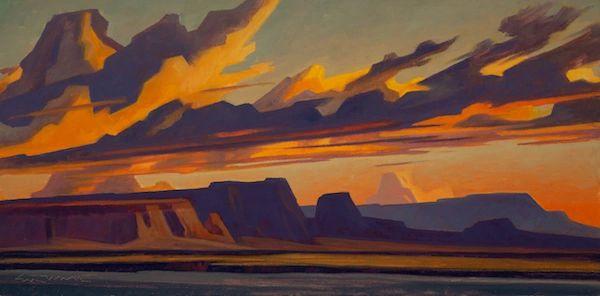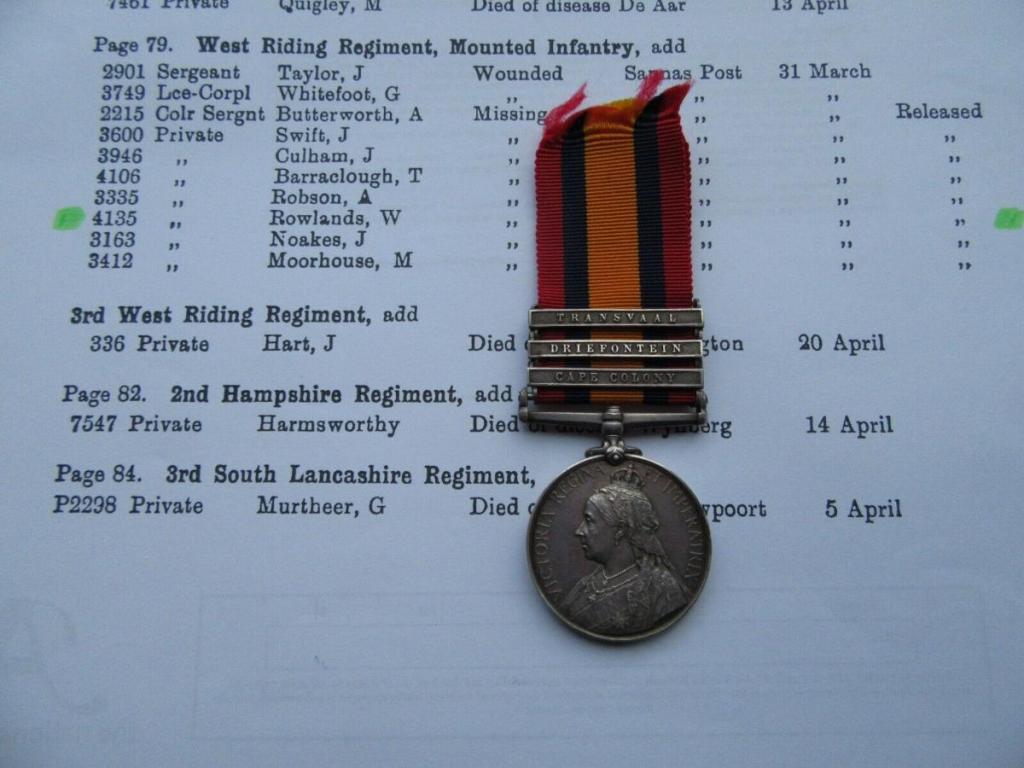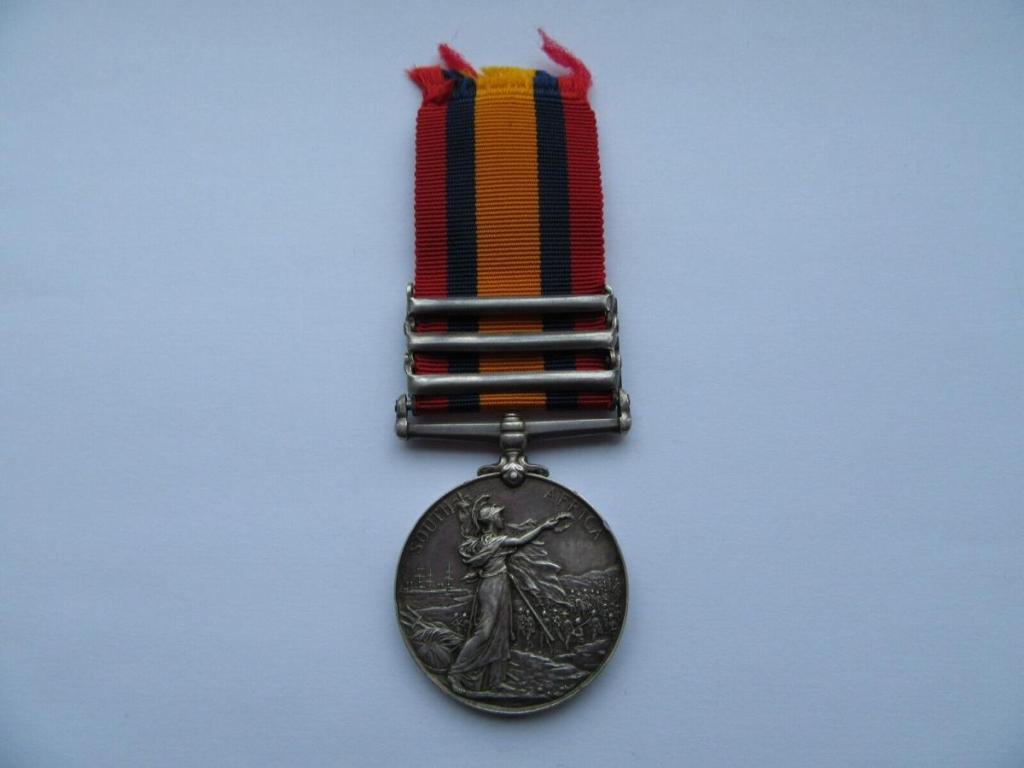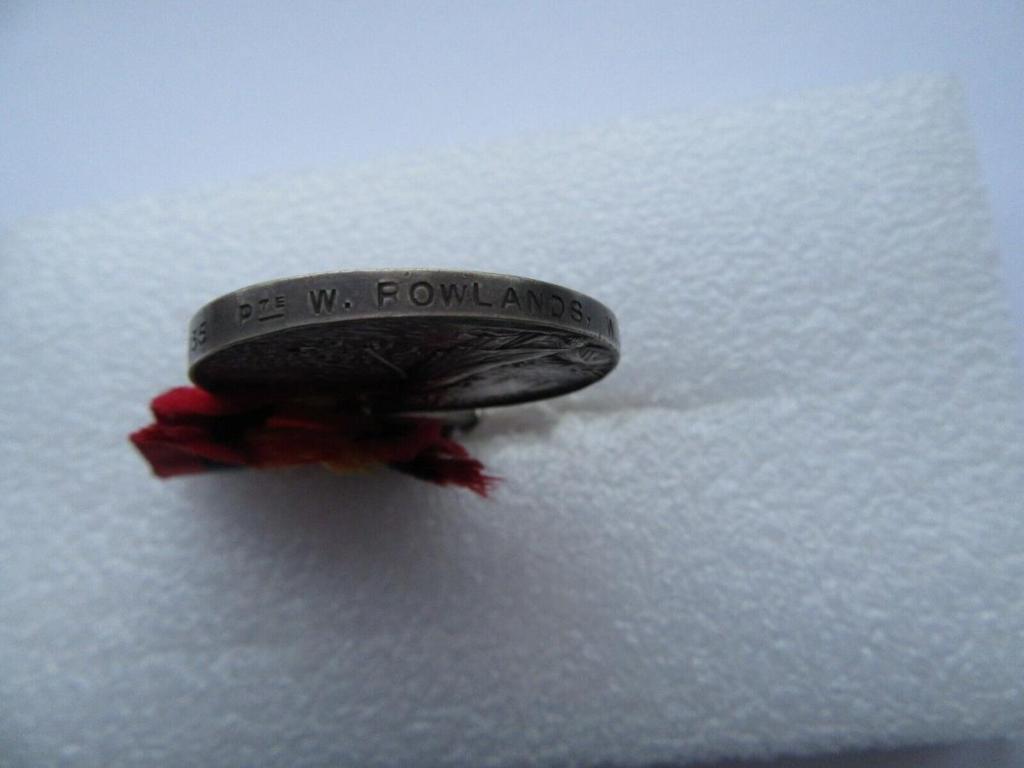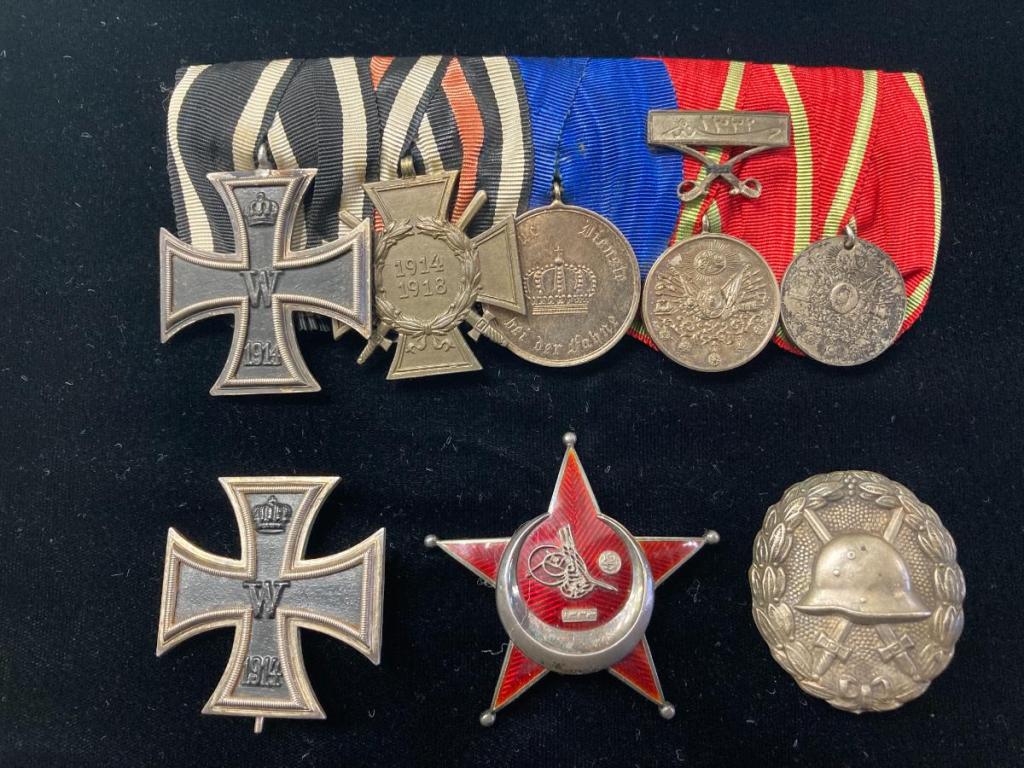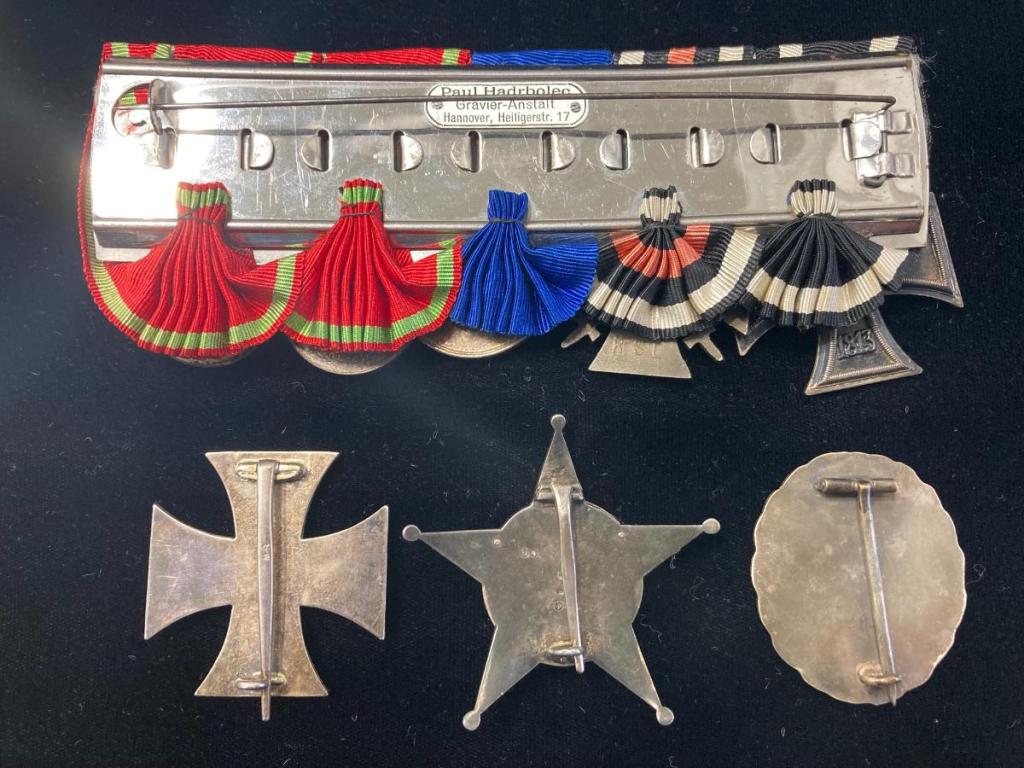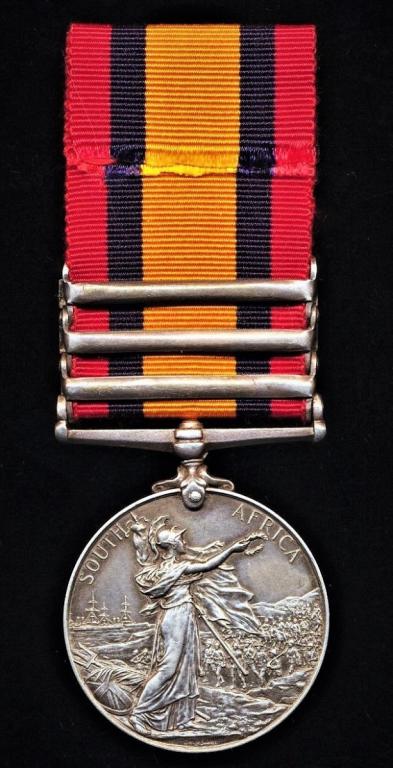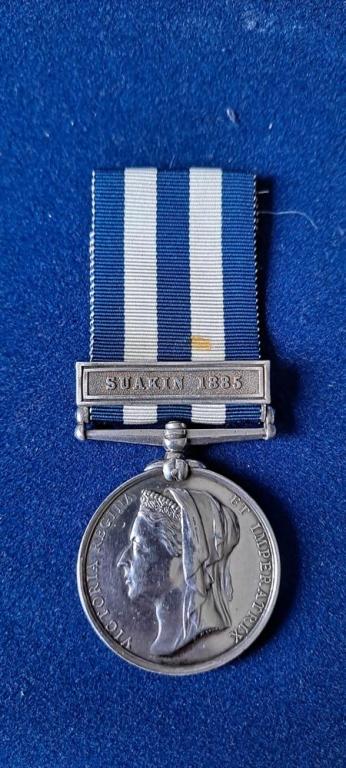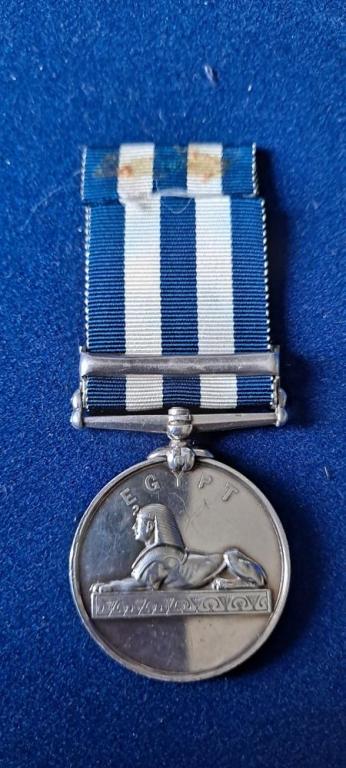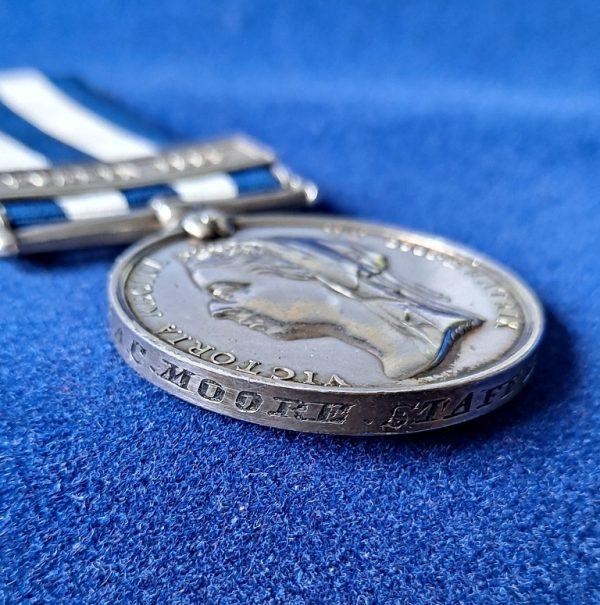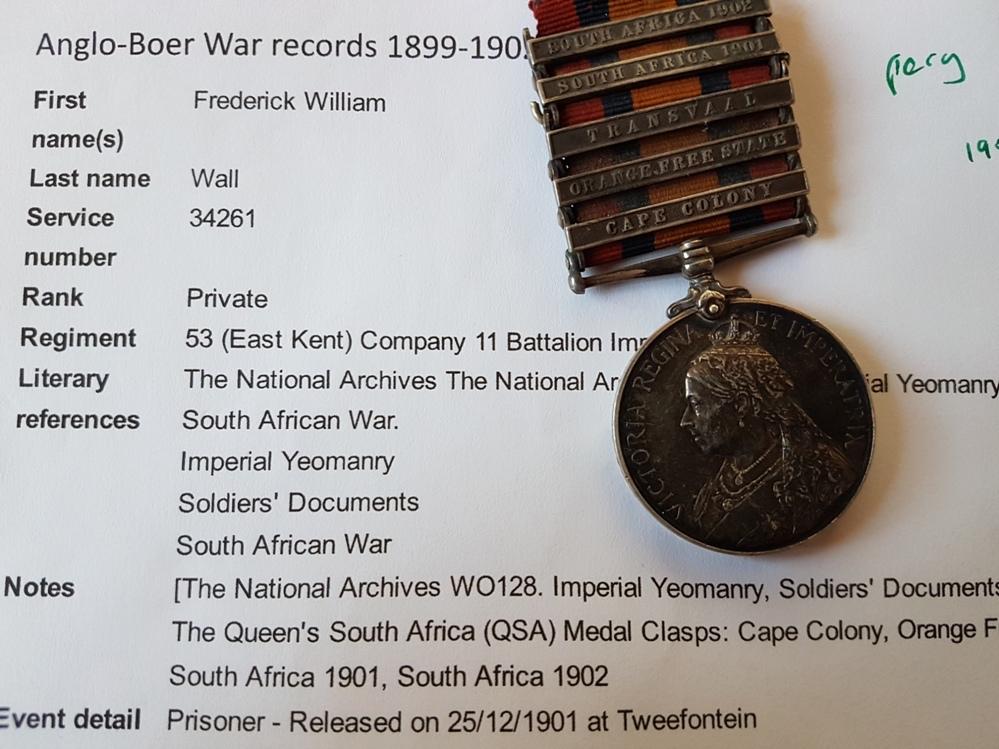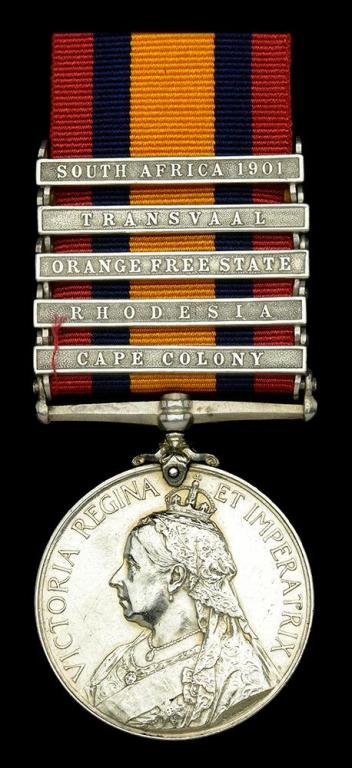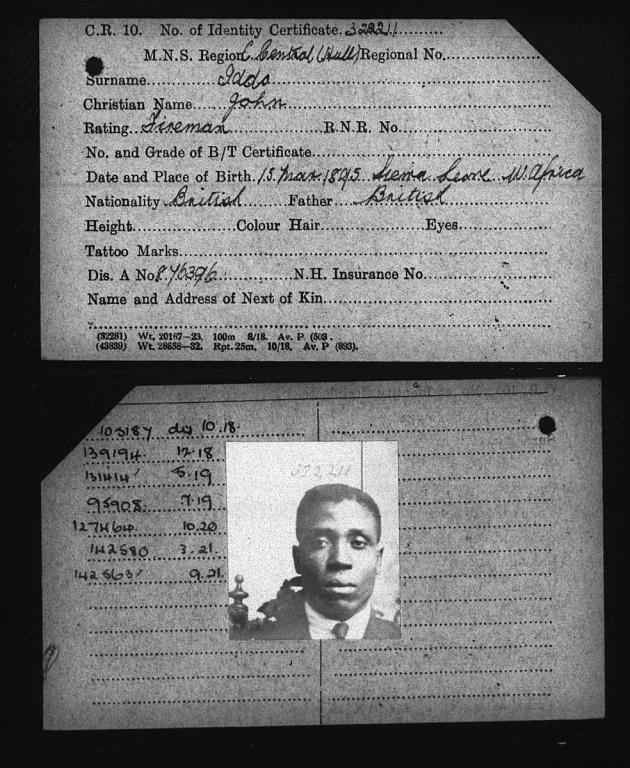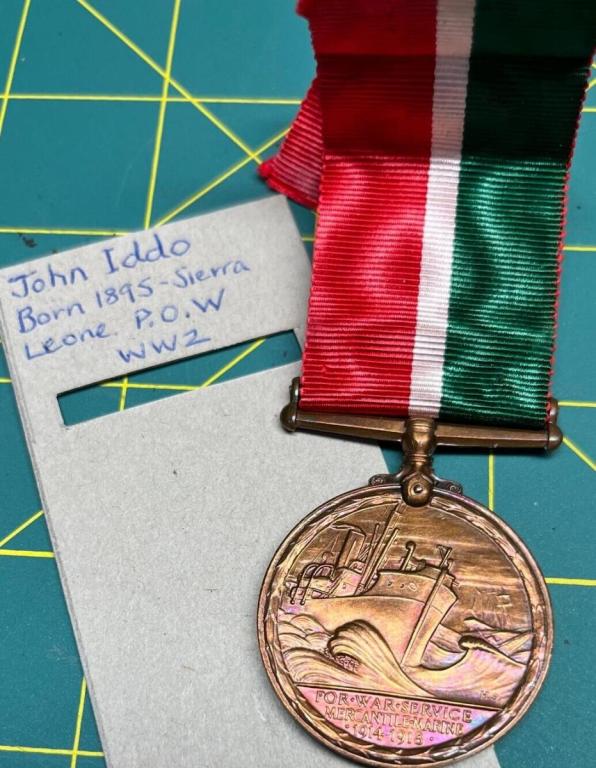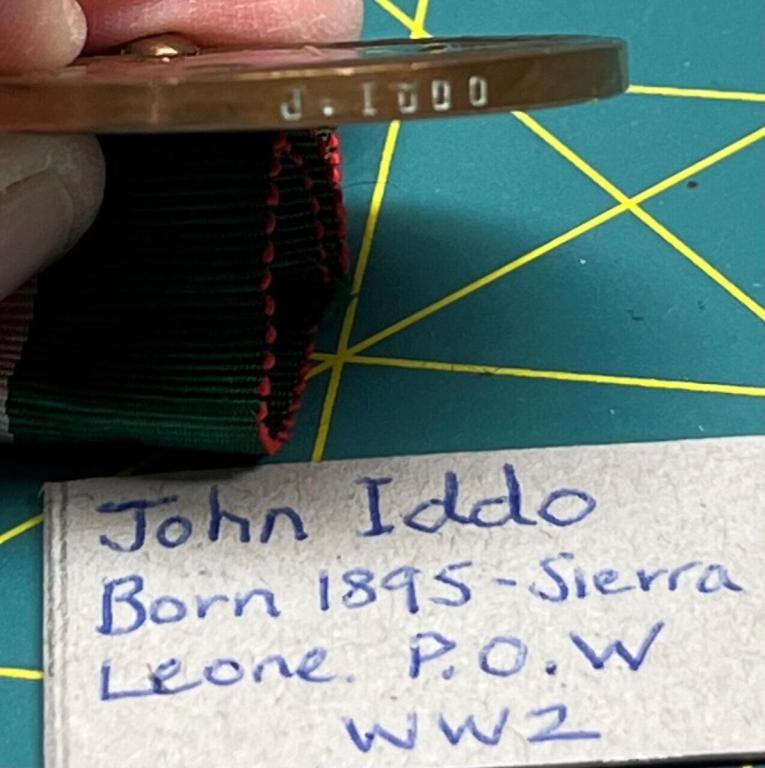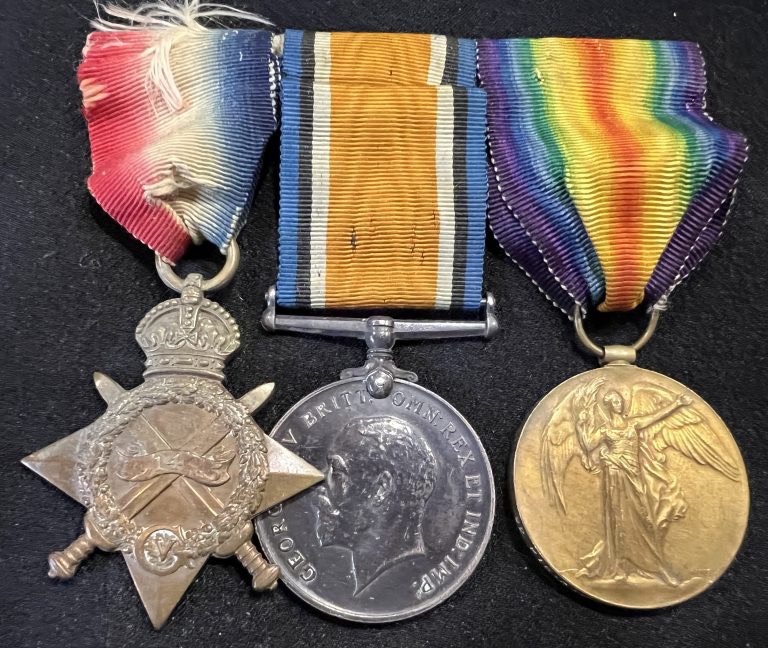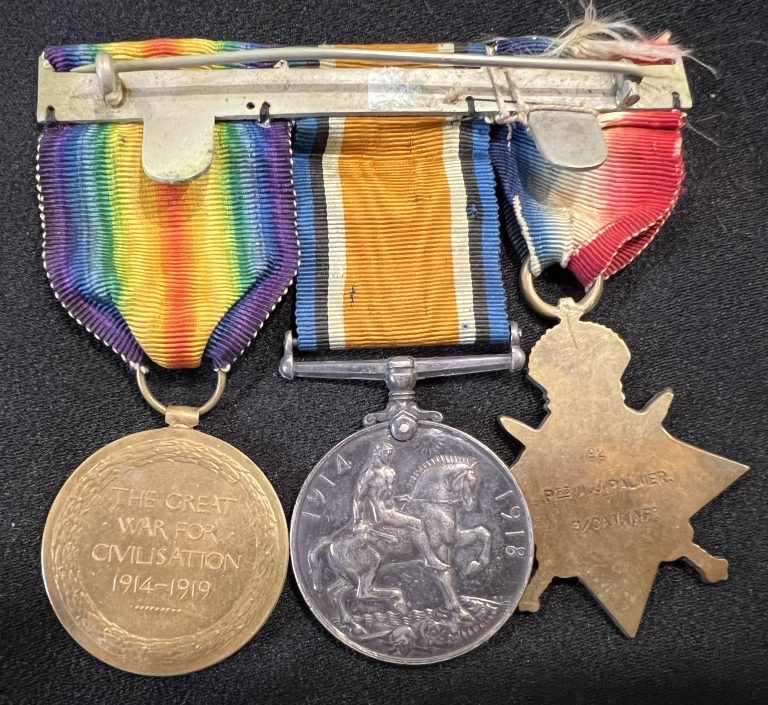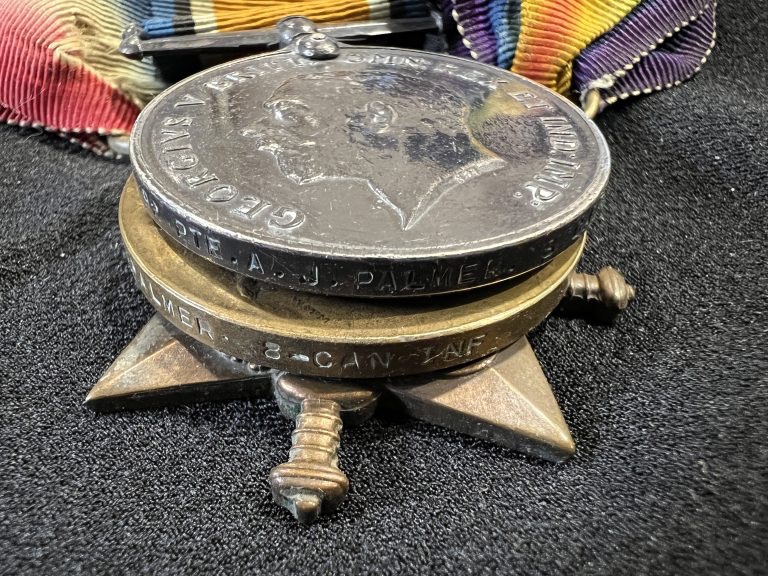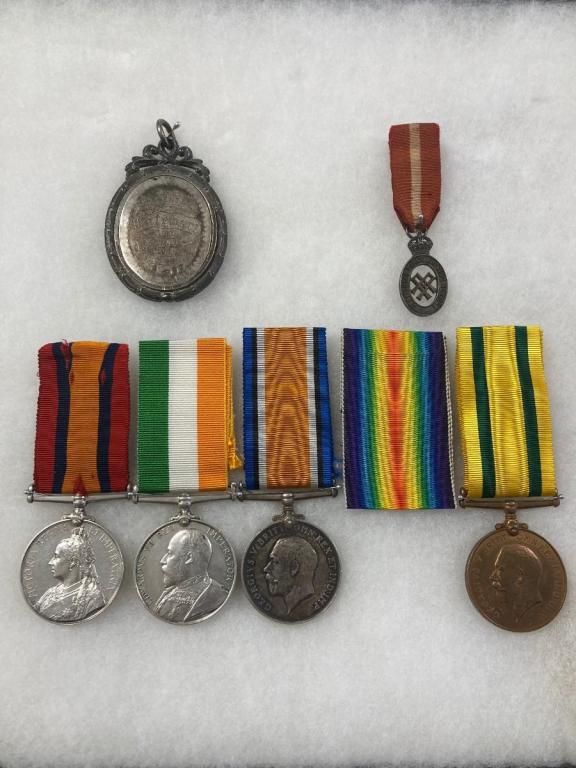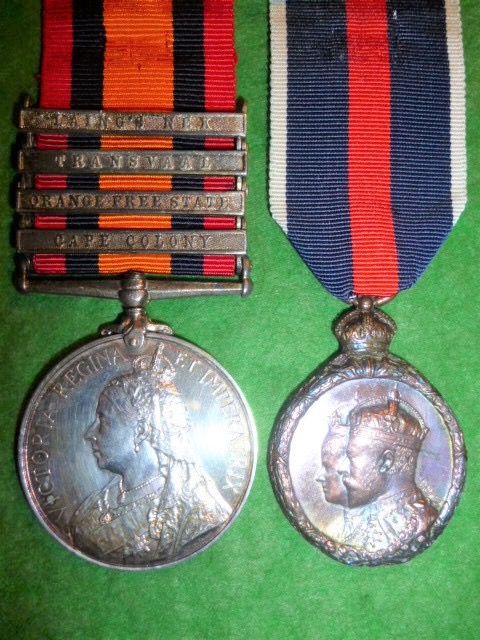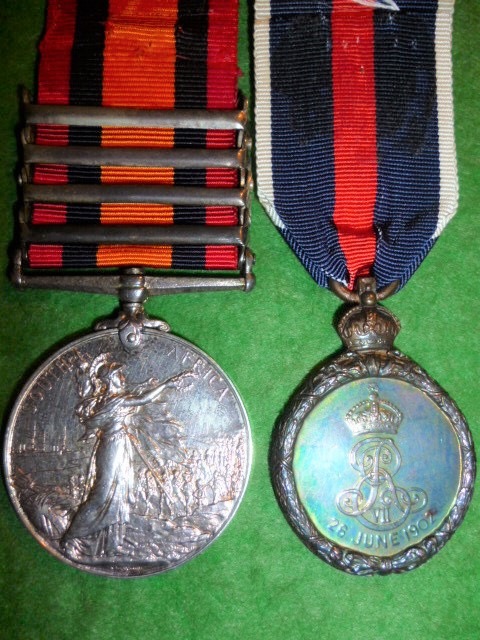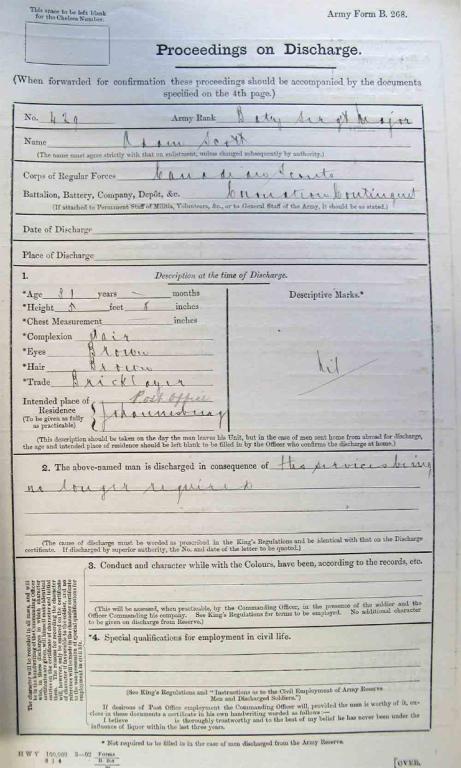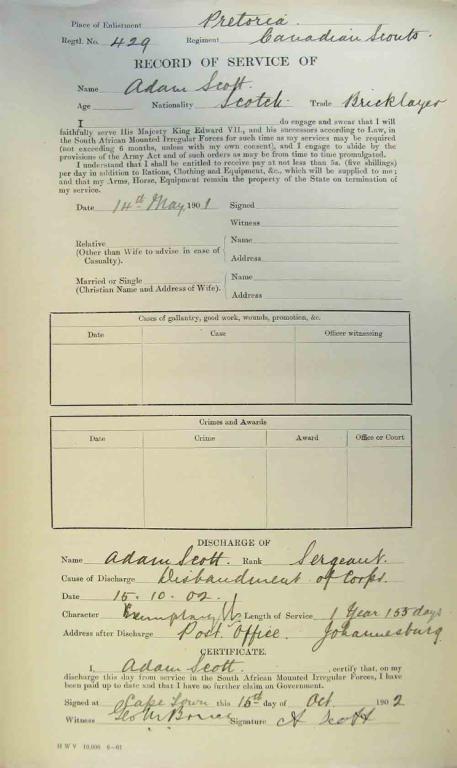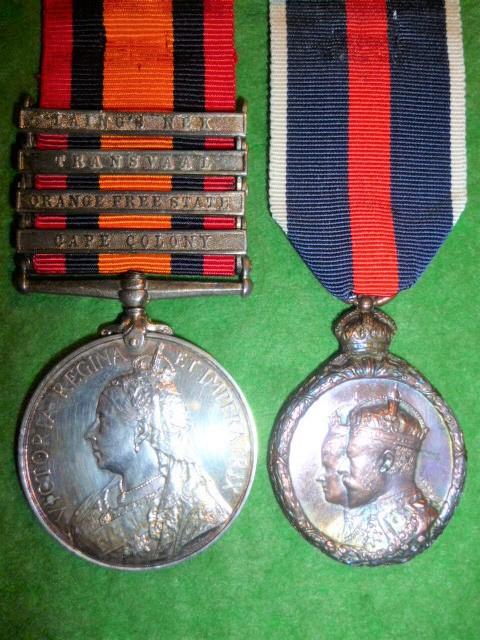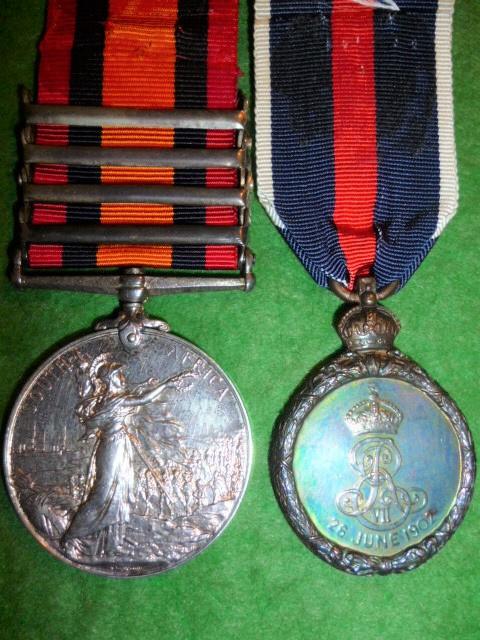-
Posts
1,770 -
Joined
-
Last visited
-
Days Won
3
Content Type
Profiles
Forums
Blogs
Gallery
Events
Store
Everything posted by azyeoman
-
Another PoW for Sannah's Post. QSA: CC, Drif, TR (entitled to SA01) Officially named to 4135 Pte. W. ROWLANDS. W. RIDING REGT Rowlands is NOT entitled to a KSA. Regimental rolls show this combination of clasps is unique to the regiment and that Rowlands was the sole soldier in the West Riding Regt. to receive them. ROWLANDS is shown on the South African War Casualty Roll as missing Sannah’s Post 31 March with the words released. Some research from Ancestry confirms he was part of the Mounted Infantry at Sannah’s Post.
-
It's now 2022 and I was wondering if you've added any more TWMs recently? Thanks.
-
This is a great collection. Have you added any more recently?
-
Through my inquiries, Joshua at Liverpool Medals was able to send me this great photo and bio on Mr. A. C. Moore. Medals to translators seem to have exceptionally interesting stories. Major A. Churchill Moore former Egyptian Civil Service, photographed circa 1918, wearing the ribbon of the Egypt Medal, the Khedives Star, and his Order of Medjidie. (Copyright the Imperial War Museum) He is wearing A Royal Automobile Club cap badge, which is rather unusual. It was a unit of volunteers who were drivers for the British Army during WW1. Albert Churchill Moore, who went by "A. Churchill Moore", was Recipient of the Order of Medjidie 3rd Class Neck Badge for service as Inspector in the Administration of the Daira Sanieh. (Shortly after the massive 1898 Scanadal when the Daira Sanieh Corporation was sold off to pay for £7m in debts). He was born on 21st February 1864 inside the British Consulate in Jerusalem, Israel, which was Palestine at that time. He was born in what is now the "Mahane Yehuda Police Station", a historic building at 107 Jaffa Road in Jerusalem, which still stands. Palestine at the time was under primarily Ottoman Control, the native tongue being Arabic; thus Mr. A. C. Moore learned Arabic. His father was the long serving British Consul to Jerusalem, Noel Temple Moore, newly arrived for his post, which he would serve for 25 years. He also happened to be the Nephew of the distinguished Lieutenant General Sir Henry Moore KCB CIE. His father Noel was a Popular British Consul who had aided Jews in attempting to settle in Palestine, which was strongly opposed by the Sultan, as British Residents were only allowed to remain for Pilgrimage purposes. He is most noted for personally accompanying the Prince of Wales (King Edward VII) on his Visit to the Holy Land through Syria and Palestine. His father was also employed on special services in Egypt during 1882-3 when he wrote the "Dufferin Report", detailing how the occupation was to benefit Egypt, following the Egypt-Sudan War. Lord Dufferin, commended him, writing, "I desire to express to you my very best thanks for the valuable assistance you have rendered me during the time you were attached to my mission at Cairo. Your knowledge of Arabic and thorough acquaintance with the East and the habits and thoughts of its inhabitants, enable you to place at my disposal an amount of information in regard to the wishes and aspirations of the people of this country, which otherwise it might have been difficult to obtain." By the time of Suakin 1885, Mr Albert Churchill Moore, now about 21 years old, had found employment with the Egyptian Civil Service, and given his father's standing, likely with little resistance. No doubt he was fluent in Arabic being raised his whole life in Jerusalem and the son of one of the finest British Arabic Speakers. He had a career in the Civil Service, and in 1894 he was stationed in Cairo where he married. He had retired in the 1911 census, was living in Hove, Sussex, and self described as 47 year old "Egyptian Civil Service, Retired" He died in Hotel Beau Syoni in Pau, the Alpes-De-Haute-Provence, France during 1926. (Living a nice retirement, having received a considerable chunk of the Estate from his Uncle Sir Henry Moore in 1916)
-
I like the dark mode, and it's not an issue to make a selection when signing in.
-
Queens South Africa Medal 1899-1902. Silver issue, with 3 x clasps 'Natal', 'Orange Free State' & 'Transvaal' (3996 Pte. W. Lewis Gloucestershire) Private Walter Lewis, is confirmed being a Prisoner of War when he was captured by the Boer enemy on, 30 October 1899, at Nicholson's Nek (Farquhar's Farm), South Africa. Lewis’ QSA medal & all 3 x clasps are verified per the campaign medal roll of 1st Battalion Gloucestershire Regiment (ref WO 100/183), which was compiled and signed at Colombo, Ceylon Colony, on, 7 June 1901. Lewis was also tried & convicted for 'Striking his Superior Officer' and received 84 days imprisonment with 'Hard Labor' on 16 September 1893. Walter Lewis, son of, George Lewis (Postman) & Ann Lewis (nee Pincott) was a native of, Chalford, Gloucestershire, England, where he was born circa 1873. He enlisted in the British Army, at, Cirencester, England, on 13 June 1893, when he was 20 years & 8 months old. His next of kin was his mother, Ann Kirby (she had re-married), who was residing at, Chalford Hill near Duke of York Inn, near Stroud, Gloucestershire. Prior to enlisting, he was employed as a 'Laborer', and had served in the, 4th (Militia) Battalion Gloucestershire Regiment. Lewis was posted to his local infantry regiment, to serve with 1st Battalion Gloucestershire Regiment. Lewis was contracted to serve seven (7) x years with 'The Colors', and five (5) x years on the Army Reserve. Lewis' overseas service was as follows: - Malta: 01/11/1893 - 20/11/1895 - Egypt: 21/11/1895 - 05/02/1897 - India: 06/11/1897 - 23/09/1899 - South Africa: 24/09/1899 - 23/08/1900 - Ceylon: 24/08/1900 - 29/12/1902 Lewis took his discharge from the British Army on 12 June 1906; his Regular Army service papers of are accessible at The National Archives. Photos to follow.
-
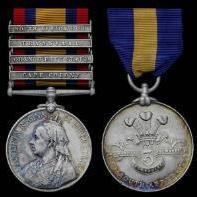
My Prisoner of War Collection
azyeoman replied to POWCollector's topic in Great Britain: Orders, Gallantry, Campaign Medals
Hi Rob, What a great historical group. I like the way Spinks mounted it. Oddly you don’t see the Spinks “tailor tags” very often. -
Another new Imperial Yeomanry-PoW, QSA sadly missing its accompanying '14 Star Trio. QSA: CC, OFS, TR, SA01, SA02 officially named to: 34261 PTE. F. W. WALL. 53RD COY IMP. YEO: Frederick William Wall was born in Brighton, Sussex, in 1874. He died in Brighton in 1926. The 1881 Census shows Frederick and Percy Wall lived with their parents and other siblings in New England Road, Brighton, Sussex. The 53 Company Imperial Yeomanry Royal East Kent Regiment Frederick Wall was captured and taken prisoner of war in the action at Groenkop, also known as Christmas Kop. He was released on 25/12/1901 at Tweefontein. Details of the event are on FMP and are as follows. At Groenkop, a farm in the Orange Free State (Harrismith district; Free State, 35 km east of Bethlehem). A force of some 500 men of the Imperial Yeomanry with a gun and maxim all under the command of Major F.A. Williams, 1st South Staffordshire Regiment, was in camp on the farm protecting the head of a blockhouse line under construction from Harrismith to Bethlehem. The detachment was camped on a hill, Groenkop, with precipitous sides to the west and south and a gentle, well entrenched slope to the east. On the night of 24/25 December 1901, detachments from eight commandos comprising some 500 burghers under the command of Chief-Cmdt C.R. de Wet silently scaled the steep west face in stockinged feet taking the defenses completely by surprise. Led by Cmdt W. Mears and Cmdt G.A. Brand, the burghers completely overran the camp within an hour. De Wet left at dawn with some 240 prisoners as well as two guns, 20 wagons, supplies of ammunition and tents, and 500 horses and mules. British casualties were 57 killed (including Williams) and 88 wounded; the Boers lost 14 killed and 30 wounded; among those killed were Cmdt G.J. Olivier of the Bethlehem commando. This action is known to Afrikaner historians as Groenkop, Tweefontein or Krismiskop, Groenkop having become known as Christmas Kop. (HM & MGM Jones). First World War Service L/5595 F W Wall served in the First World War. He entered France 7th September 1914 and is entitled to a 1914 Mons Star Trio with Clasp and Roses as per his Medal Index Card. He was promoted to Warrant Officer First Class, 1st East Kent Regiment, The Buffs. He died in Brighton 1926 aged 52 years. If anyone knows the location of Wall's '14 Star Trio, please contact me as I would like very much to reunite Wall's medal group. Thank you in advance. More on the Battle of Groenkop In the Battle of Groenkop (Battle of Tweefontein) on 25 December 1901, Head Commandant Christiaan de Wet's Boer commando surprised and defeated a force of Imperial Yeomanry under the command of Major Williams. Background By late 1901, de Wet's guerilla force based itself near the settlements of Lindley, Bethlehem and Reitz in the northeast part of the Orange Free State. On 28 November, de Wet called a krijgsraad (war council) of the still-active Boer leaders near Reitz. They determined to strike back at their British tormentors, who numbered 20,000 men. As part of Lord Kitchener's strategy, the British constructed lines of blockhouses and barbed wire across the veld. The blockhouse lines were designed to restrict the movements of the Boer guerrillas so they could be trapped by British mobile columns. One line of blockhouses reached from Harrismith to the Tradoux farm, 25 miles (40 km) east of Bethlehem. To protect the construction, Major General Sir Leslie Rundle deployed four dispersed forces. Rundle with 330 men and one gun guarded the wagon road; the end of the blockhouse line was held by 150 infantry; a 400-man regiment of the Imperial Light Horse lay 13 miles (21 km) to the east at Elands River Bridge; Major Williams with 550 men, mostly of the 11th Battalion, Imperial Yeomanry, a 15-pounder gun and a pom-pom held the 200-foot (61 m) high Groenkop. The battle De Wet carefully scouted the Groenkop position for three days. He noted that the British posted their sentries atop the sheer west side of the kop, instead of at the bottom where they could give timely warning of an attack. The Boer leader determined to scale the west side using the trace of a gully. At 2:00 am on Christmas morning, de Wet's commando clambered up the steep slope in single file with their boots removed so as to minimize any noise. The surprise was nearly total. Challenged by a single sentry when they were over halfway to the top with a few scattered shots, the Boers, who were ordered into battle by de Wet shouting "Stormt Burgers" swarmed up and over the crest. They began firing downhill into the British tents, inflicting a "massacre." Savage fighting lasted about 40 minutes before the British gave up. The aftermath The next morning, one of the 206 British prisoners of the Boers noted that his foes were so short of clothing that some wore women's attire. The 250 unwounded British prisoners of war were stripped literally naked before they were turned loose the next day. Kitchener wrote, "It is very sad and depressing that the boers are able to strike such blows, but I fear ... we shall always be liable to something of the sort from the unchecked rush of desperate men at night."
-
A very nice Imperial Yeomanry addition for Boshof and with the unusual clasp "Rhodesia". Queen’s South Africa 1899-1902, 5 clasps, Cape Colony, Rhodesia, Orange Free State, Transvaal, South Africa 1901; There are unofficial rivets between state and date clasps - Officially named to 4779 Tpr: G. W. Suter. 50th. Coy. 17th. Impl: Yeo: George William Suter was born in Gosport, Hampshire, in 1877 and attested for the Imperial Yeomanry at Winchester on 14 February 1900, having previously served in the 3rd Volunteer Battalion, Hampshire Regiment. He served with the 50th (Hampshire) Company, 17th Battalion Imperial Yeomanry in South Africa during the Boer War from 7 April 1900 to 9 June 1901, and was captured and taken Prisoner of War at Boshof on 16 January 1901. The column was subjected to a fierce attack from the enemy, who were strongly posted on a long range of kopjes which commanded the road. The fight continued for over three hours before the enemy were dislodged from their position by a frontal advance on foot of the Hampshires and other troops, and at 2 p.m. the Boer position was in our hands. During the engagement the 50th had no casualties except five horses shot in the early part of the fight, and one man, Trooper Suter was captured and was carried to the ruins of the Viljoens Kloof (which had been burned by the Squadron upon its former visit). He was told he would be shot in the morning, but during the night he effected his escape and rejoined his comrades in Boshof. (Noted in Rhodesia - and After, by Sharrad H. Gilbert.) Suter was discharged on 15 June 1901, after 1 year and 122 days service.
-
Here's a very interesting addition. It's a MMWM to a Fireman & Trimmer from West Africa. Although it's Great War medal, Iddo was a PoW in WWII. John Iddo, (3222211) Born 17 March 1895 in Cape Rehaus, Sierra Leon, West Africa. He was the husband of Annie Iddo, of North Shields. In WWI, Iddo was a trimmer on the SS Ethiopia in 1915. It was captured by the UB-41 and then torpedoed and sunk. Iddo survived and went on to serve the remainder of the war and in WWII. At 21.03 hours on 17 March 1942 the unescorted Allende (Master Thomas James Williamson) was hit on the starboard side amidships by one torpedo from U-68 about 18 miles south of Cape Palmas, Liberia. Five crew members on watch below were lost. The master, 30 crew members and seven gunners abandoned ship in two lifeboats and were questioned by the Germans before the U-boat fired a coup de grâce at 22.28 hours. The G7a torpedo hit aft and caused her to sink by the stern within five minutes. The survivors with Iddo made landfall at Tabou, French Ivory Coast and were interned for four months by the Vichy French authorities at Bobo Dioulasso and Bamako. Two crew members died of illness during the internment and another shortly after being released. He returned to Bathurst on 16 July 1942. John Iddo was awarded a BWM named J. Iddo. If anyone know its location, please contact me as I'd like to reunite the group. He was also entitled to the 1939 Star for his WWII service. Interestingly, the '39 Star is his only medal for WWII per the BT 395/1/47/468 document at the National Archives.
-
1914/15 Star (92 Pte A.J. Palmer, 8/Can Inf.; British War and Victory medal (92 Pte A.J. Palmer, 8-Can Inf). Arthur James Palmer was born in Somerset England 2nd December, 1890. He was living at Norwood, Manitoba at the time of enlistment 23 Sept, 1914. On April 24, 1915 he was taken prisoner of war at St. Julian, Ypres and sent to Germany. Palmer was repatriated by 30/12/1918. He was one of about 1,400 Canadian PoWs captured on 24/25 April 1915 during the battle of Ypres. (See the above pair to Pte. J. Crawford, 7th Can. Inf. who was captured on the 24th of April.) Arthur James Palmer died on 17/07/1945. There were a total of 3,853 Canadians captured in WWI according to Wigney in Guests of the Kaiser. For more information visit: https://cdnhistorybits.wordpress.com/2017/03/14/canadian-pows-ww1/.
-

Attention to detail….
azyeoman replied to bigjarofwasps's topic in Great Britain: Orders, Gallantry, Campaign Medals
It’s obvious he couldn’t care less about his medals that were given to him by the Queen. (By virtue of the fact that he is her nephew). I wonder what the late Princess Margaret would have thought? -
Please post your EVII 1902 Coronation groups. The one below is to 429 Corpl. A. Scott, Canadian Scouts. The group is missing his KSA with two clasps possibly named to him as Batt. Sgt. Major. The medal was awarded in silver and bronze. There were 3,493 issued in silver to members of the Royal family, dignitaries, senior government officials and service officers who were present at the coronation ceremony, performed extra work in its preparation, or who were involved in the coronation parade. There were 6,054 bronze medals issued to selected NCOs and other ranks at the coronation parade. The bronze medal was also given to one seaman or marine of 'very good' character on each ship at the Spithead Naval review held on 16 August 1902. The two members of the Queen Alexandra’s Imperial Military Nursing Service who nursed the King during his pre-coronation illness also received bronze medals. The medal was worn on the left chest from a ribbon with other coronation and jubilee medals. These were worn before campaign medals until November 1918, after which the order of wear was changed, with such commemorative medals now worn after campaign medals and before long service awards. Ladies could wear the medal near their left shoulder with the ribbon tied in the form of a bow. The medal was designed by Emil Fuchs. It is oval, 30 by 38 mm (1.2 in × 1.5 in) and surmounted by a crown. The obverse has a profile of King Edward VII and Queen Alexandra, crowned and facing left and surrounded by a wreath that forms the rim of the medal. The reverse shows the king's cypher above the date 26 June 1902, surrounded by a wreath in the same form as on the obverse. It was awarded unnamed. Due to the king falling ill with appendicitis, the coronation, planned for 26 June 1902, had to be postponed while the monarch recovered from surgery, and the coronation was actually held on 9 August 1902. This change happened too late to be reflected on the medals, which bear the earlier date. There are five other different coronation medals: Mayors & Provosts; Police, Ceylon, Hong Kong and Natal. The medal awarded to Royalty, officials, dignitaries and the armed forces, described above, has a ribbon of dark blue with one central red stripe and white edges on either side. The special medal, in silver only, awarded to Mayors and Provosts is circular, but otherwise of a broadly similar design. It has a ribbon of dark blue with red edges and a narrow white central stripe. The Police Coronation Medal was a larger circular medal of a different design, awarded in both silver and bronze, suspended from a ribbon of red with a narrow blue central stripe.


